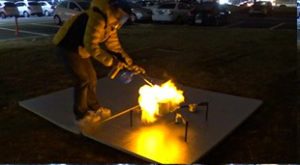 What if the Human Torch and Spider-man had a robotic baby?
What if the Human Torch and Spider-man had a robotic baby?
Aside from raising interesting questions of custody (Would the Thing be the godfather?), such a cybernetic wonder would be able to crawl walls and withstand four-digit, fiery temperatures – kind of like the latest invention from a Korean think tank.
Dubbed Fireproof Aerial RObot System (FAROS), the new firefighting drone from the Korea Advanced Institute of Science and Technology (KAIST) can not only detect fires in the tallest of skyscrapers, it can also search an engulfed building and transfer real-time data to human firefighters to build a better game plan for extinguishing a blaze.
“As cities become more crowded with skyscrapers and super structures, fire incidents in these high-rise buildings are life-threatening massive disasters,” said lead KAIST researcher Hyun Myung. “The FAROS can be aptly deployed to the disaster site at an early stage of such incidents to minimize the damage and maximize the safety and efficiency of rescue mission,” he added.
With the ability to roll over walls or fly, FAROS can deploy a 2-D laser scanner, altimeter and “Inertia Measurement Unit” sensor to navigate a building autonomously all while withstanding heats in excess of 1,832 degrees Fahrenheit. The UAV is coated with aramid fibers – basically a cross between artificial asbestos and Kevlar body armor – which protect FAROS’ delicate electronics. A thermoelectric cooling system helps maintain a temperature-regulating layer of air around the drone as well.
Using a thermal-imaging camera, FAROS can recognize objects and people and can even help locate the fire’s point of ignition. “The research team has recently started to enhance the performance of the fireproof design for the exteroceptive sensors including a 2-D laser scanner and a thermal-imaging camera because those sensors could be more exposed to fire than other inside sensors and electric components,” Myung added.
As drone technology improves, firefighting agencies, as well as other public safety organizations, are expected to especially reap the benefits of innovations that can save lives. Recently, researchers at Olin College and MIT joined forces with UAV firm Scientific Systems to develop a vanguard of self-flying UAVS that could gather airborne, real-time data to send to crews fighting dangerous wildfires. The drones won’t be able to literally fight the fires but they will converge to create real-time data sets for firefighters and other emergency officials. Logistical data can help experts pinpoint how the fire is likely to spread and how best to deploy on-the-ground crews.
Jason is a longstanding contributor to DroneLife with an avid interest in all things tech. He focuses on anti-drone technologies and the public safety sector; police, fire, and search and rescue.
Beginning his career as a journalist in 1996, Jason has since written and edited thousands of engaging news articles, blog posts, press releases and online content.
Email Jason
TWITTER:@JasonPReagan
Subscribe to DroneLife here.







[…] źródła: www.popularmechanics.com https://dronelife.com […]